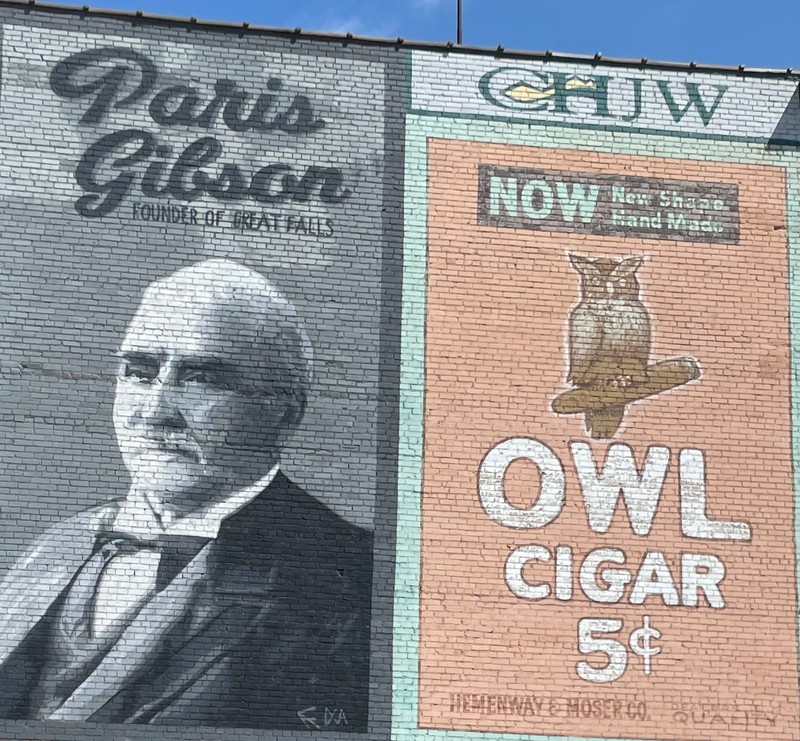Paris Gibson Black and White Mural
Introduction
Text-to-speech Audio
The Paris Gibson Mural is located on the south wall of the CHJW Law firm building. Paris Gibson was the founder and long-time community leader in Great Falls. Next to the mural is a "ghost" sign from the old days when the buidling was advertising Owl Cigars.
Images
Paris Gibson, Founder of Great Falls

Backstory and Context
Text-to-speech Audio
Paris Gibson was born on July 1, 1830, in Brownfield, Maine. He was the son of Abel and Anne (Howard) Gibson. He graduated from Bowdoin College in 1851. In 1853 he was elected to the Maine legislature. In August 1858, Gibson married Valeria G. Sweat, who was born in Brownfield, on Nov. 30, 1839. The couple had four children, two of whom died at an early age. The surviving sons, Phillip and Theodore, later helped their father in some of his business activities. In 1859, the new couple moved to St. Anthony Falls, Minnesota, (now Minneapolis). There Gibson and several business partners set up the Cataract Mill, the first flourmill in Minneapolis, and the North Star Woolen Mill. He was a member of the Masonic lodge in Minneapolis and also helped establish the first public library there. Gibson also served on the University of Minnesota Board of Regents from 1871 through 1879. He suffered heavy financial loss in the Panic of 1873.
In 1879 Gibson migrated to Montana. He tried sheep ranching at Fort Benton and purchased several acres of land there. In 1885 he had 140 sheep for sale. The next year he and his son, Phillip, organized the Great Falls Sheep Company. In 1883 Gibson was elected the first president of the Montana Wool Growers Association at Fort Benton, and he served in this office for 22 years. Gibson remained involved in the wool industry until 1905.
In 1885 Gibson relocated to Great Falls, Montana. Impressed with the natural resources of the Great Falls area, especially the waterpower of the falls, Gibson founded the Great Falls Water Power and Townsite Co. in 1885. Gibson began building the power company there and bought all of the land for the town site. He actively recruited settlers for the new town. In 1885 the population of Great Falls was 100, and by 1890 it was 4,000. In 1885 Gibson built the Park Hotel. In 1887 Gibson helped get the railroad to build a line through Great Falls. That same year he was elected a director of the First National Bank. In 1888 Great Falls was incorporated as a city and Gibson was elected the first mayor.
Gibson played a critical role in the expansion of the industry of western Montana. The Great Falls Water and Townsite Co. became the Great Falls Light and Power Co., and expanded its transmission lines throughout the area. Under Gibson's direction, the Great Falls Light and Power Co. built a dam on the Missouri at Black Eagle in 1890. In that same year Gibson co-founded the Boston and Montana Smelter Company in Great Falls, which became the major smelter for Butte copper. This smelter company helped to develop mining in the Great Falls region. In 1912, several power companies including the Great Falls Light and Power Co. were incorporated into the Montana Power Co.
Gibson was very active in civic affairs both as a mayor and as a private citizen. He advocated railroad expansion in Montana. He also made several improvements to the city, including the extensive parks system and the expansion of electric power lines to all of the homes in the city. In 1889 he represented Cascade County at the State Constitutional Convention and served as a member of the Montana Senate the same year. In 1901, when he was 71, the state legislative assembly elected him a U.S. Senator. He served until 1905. Gibson, as the town founder and planner, is considered the "father of Great Falls." Paris Gibson died on Dec. 16, 1920. His wife Valeria died in Great Falls on Aug. 20, 1900
Sources
Archives West Biographical Note
